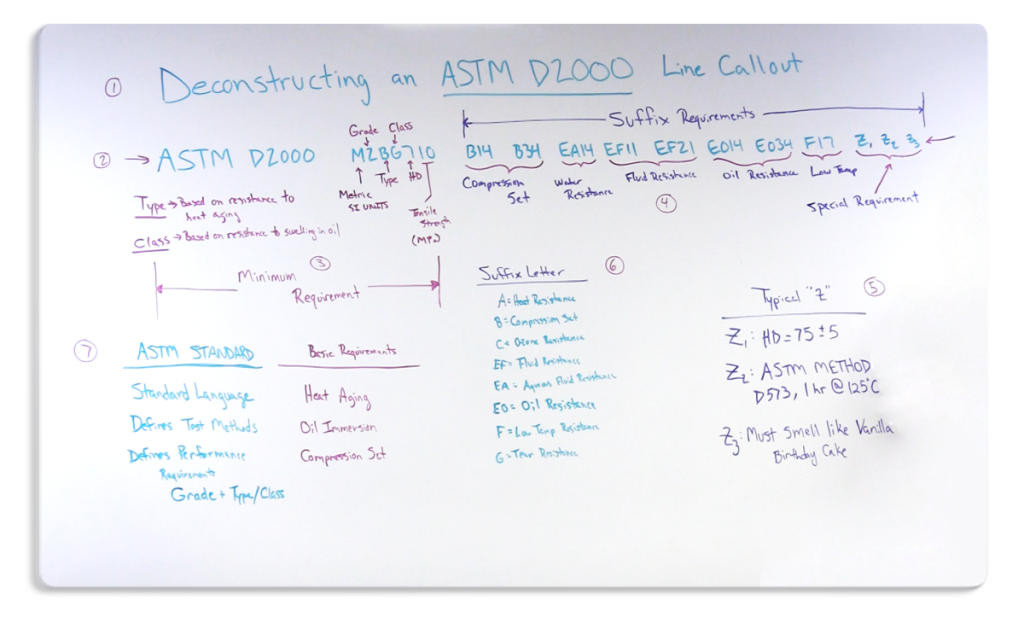
Click on the image to open in a New Tab.
Video Transcript
In many elastomer products, ASTM D2000 is utilized as the standard to communicate the performance requirements of the materials based on the customer’s expectations or the demands of the application.
An ASTM D2000 Line Callout

An ASTM D2000 line callout looks like this and is the entire line that you can see between my arrows. We have a specification that applies to the line call out. We have some basic requirements information and then we have what’s known as the suffix requirements portion of the line call out.
The Basic Requirements
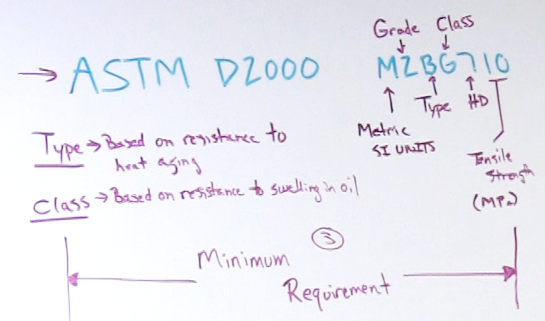
So, within the line call out, within the basic requirements:
- You have usually proceeding with an M which indicates metric units, so SI units.
- You have a number following the M that indicates the grade of the material.
- The first letter following that number is the type. The type for the materials is actually based on resistance to heat aging.
- After that, you have class. The class is based on resistance to oil swelling.
- Following that, we have a single digit that is representative of the hardness of the rubber. This has a 7 that could be a 70 durometer material plus or minus five. It also could be a 65 durometer material plus or minus 5, it could be a 75 durometer material plus or minus five.
So we’ll see that the durometer if that is a specific target you’re going for, you may need to add an additional suffix requirement to explain that.
- Then the last two digits are actually representing the tensile strength of the material given in megapascals.
What you see on the left-hand side of the line call out – this is actually the minimum requirement that you need to specify an ASTM D2000 material. With this requirement, there is a set of basic requirements automatically imposed regardless of the grade of the material and without the existence of any of the suffix requirements. Those basic requirements include tests and performance results for heat aging, oil immersion, and compression set.
The Suffix Requirements

The suffix requirements as you can see the line call out is actually the greatest portion. What I have written on the board is the longest standard line call out that you could come up with for a M2BG710 material. This is a nitrile compound. Grade 2 correlates to the performance results of each one of these tests. For a grade 2, a grade 3, grade 4, 5, and 6, each grade will have different applicable suffix requirements. It will also have different levels of minimum performance to qualify as that grade of material.
In the suffix requirements section we see that we have a preceding letter or set of letters for each suffix requirement.
- And so B14 and B34 with the B letter – they actually are both compression set tests.
- EA 14 with the EA preceding this is a resistance to an aqueous fluid or water resistance.
- We have EF and this is fluid resistance. Specifically, fuel resistance.
- We have EO 14 E0 34. These are both oil resistance tests.
- F17 is the low-temperature requirement.
- And our Z call-outs at the very end Z 1, 2, and 3 in this case – are what we call special requirements.
Special Requirements
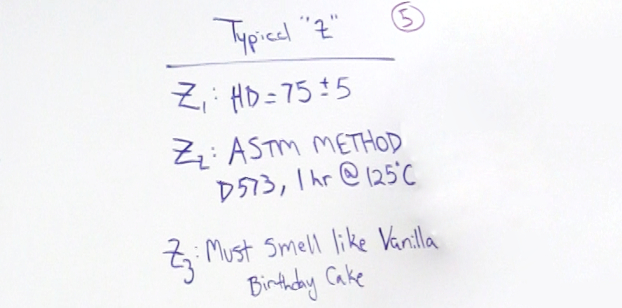
These special requirements are very powerful to help clarify specific items that may be required by a manufacturing process. A typical Z could be in this case for Z1. I wanted to clarify that the seven in the durometer call out is actually applicable to a durometer of 75 plus or minus five. I wanted to make that clear so I added the Z1 call out for that.
Z2, this could be the special processing in the manufacturing that I was referring to so maybe this elastomer component goes on to an assembly that goes through a paint line and ultimately through a paint oven there could be a small degree a small amount of time short duration or we have an elevated temperature and you wanted to evaluate the effects of that Temperature of the paint booth on the elastomer itself. So in this case, I’ve included a Z2 call out to say this ASTM method D 573 and I want to check it one hour at 125 degrees Celsius.
And then Z3 in this case. I wanted to come up with something a little bit out of the ordinary and this one I wrote down is must smell like vanilla birthday cake. It’s very unlikely that you actually need your product to have a certain fragrance, but it is possible to create a Z call out to impose any special requirement of any kind on the material. Keep in mind in doing that, you can prescribe a Z call out that is impossible to meet or could have a major cost impact on the overall material price.
So with these Z callouts, you want to make sure that you’re using what is applicable to your needs and not imposing anything above and beyond your requirements on the material.
Additional Suffix Letters
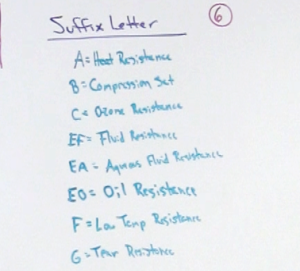
Some additional suffix letters are shown here. In addition to the ones that I’ve had this particular call out did not include a C12 call out and the C suffix would indicate an ozone resistance test. You could also have a G call out which is an air resistance test and there’s a small list of additional suffix letters that correspond to different types of tests that can be applied to different types of material. The combinations of grade, type and class could have a different list of suffix letters applied.
Benefits Of Using An ASTM D2000 Line Callout
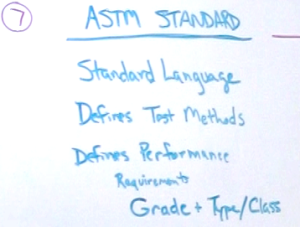
So with all of this, based around the ASTM D2000 standard, and included on your drawing the major benefits of using it –
- provides us a standard language to communicate our performance expectations and the performance requirements demanded by the application.
- It defines the test methods that you’re going to use so that the testing can be done at any accredited laboratory and it can be done consistently, and results can be comparable.
- it also defines the performance requirements by the combination of grade and type/class.
So with those things defined -both the grade, type, and class – along with the ASTM D2000 suffice requirements, we know exactly what tests need to be performed on the material and what the minimum requirements of those tests need to be to qualify for this requirement. It provides very clear information to the design team, to the manufacturer, and also to the quality assurance teams for products.